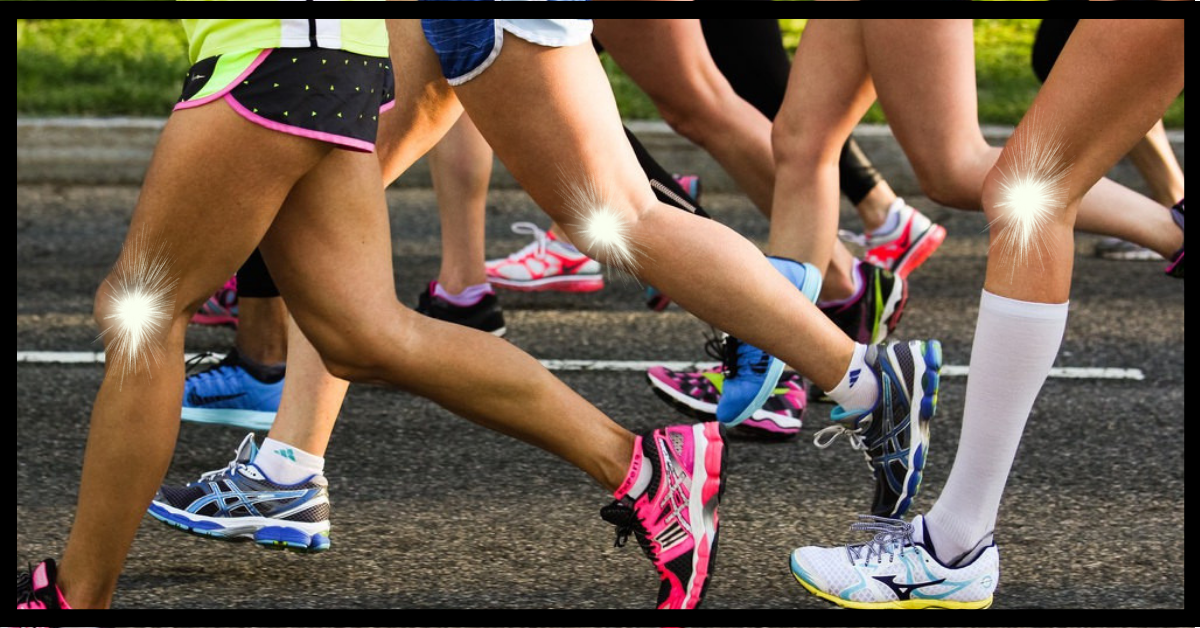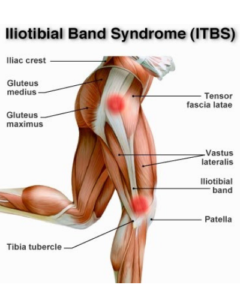
When running downhill becomes a pain in the ITB
To a runner suffering from ITB Syndrome, nothing says “hello knee pain” more than a good stretch of downhill terrain. For the uninitiated, ITB stands for Iliotibial Band. Whilst ITB Syndrome is an overuse injury, it can strike anyone, anytime, without warning. It is more often found in runners than in the rest of the population, but it’s not the exclusive domain of runners.
What is an ITB?
Your iliotibial band is a band of fascia which starts off near the outside of your hip. It then runs down the side of your leg and attaches into the kneecap and the two shin bones. The purpose of the ITB is to stabilise both your pelvis and your knee.
How does the ITB cause pain?
ITB pain can sometimes be felt in the hip, where it’s thought the ITB causes friction over the bursa that sits between your hip joint and the ITB. The bursa is a little sac of fluid that adds cushioning to the joint. Bursae can be found in joints all over the body.

It is far more common for the ITB to cause pain on the outside of your knee. What is actually happening to cause the pain is still up for debate.
For quite a while, it was thought that the pain was caused by the ITB rubbing backwards and forwards on the bone underneath it. The condition was known as ITBFS – Iliotibial Band Friction Syndrome.
Then new research showed that actually, the ITB is attached to the bottom of the thigh bone -meaning there couldn’t be any forward and backwards movement, leading to the conclusion that ITBFS, was in fact just ITBS – (that is, the F for FRICTION is taken out of the acronym, as no friction is created if the ITB is not moving). It was then posited that the pain in ITB Syndrome is caused by compression of fat structures, inflammation of bursae, or possibly due to structural changes in the ITB.
Fast forward a few years, and new research has shown that in fact the ITB does move, so could it be that the pain is caused by friction after all?
Pretty much, no-one’s quite sure exactly what is going on down there.
Read enough? Jump down to some strength training videos
Why does your knee hurt more when you run downhill if you have ITB Syndrome?
Ankle Stiffness
When you’re running on any type of terrain, the shin moves forward and downwards towards the foot and it should also rotate and twist inwards a small amount. So you need good mobility (enough but not too much) in your ankle joint. If your ankle is a little stiff and can’t move properly in these different directions, excess forces are likely to move up to the knee. The knee might be forced to bend or rotate more than it should, resulting in the tissues around the knee having to bear more load than they should. When you’re running downhill, this is exacerbated. Your foot hits the ground and stops, but the rest of your body continues in not only a forward motion, but also a downward motion, requiring greater ankle flexion.
Knee Flexion at 30 degrees
The ITB rubs against the bony bit at the side of your knee (the lateral epicondyle) just after your foot hits the ground. This rubbing happens when your knee is at or slightly less than 30 degrees of knee flexion. With downhill running, your knee is a bit straighter when your foot hits the ground than it is when you’re running on other terrain. Your foot also hits the ground with greater impact than in level or uphill running. You’ll find your ITB is far less likely to be painful if you’re running up hill, as your knee stays more bent whilst your foot is on the ground.
At least at first. If you bury your head in the sand and don’t seek treatment, you’re likely to end up with pain 24/7.
Risk factors and causes of ITB Syndrome
Weak Hip Abductors?
No-one really knows for sure what causes the ITB to give you pain. Some research shows ITB pain goes hand in hand with weak hip abductor muscles (they’re the muscles that take your leg out to the side and help to stabilise your pelvis). Whether the weak abductors are actually the cause of the ITB pain or the result of the ITB probem is uncertain.
One often cited study showed that of the 24 runners in their study with ITB issues all showed hip abductor weakness in their bad leg. The group then did 6 weeks 6 weeks of strengthening of their hip abductors and at the end of that six weeks 22 of them were pain free and could return to running.
But here’s the thing – they also took anti inflammatory drugs, undertook massage and stretching to loosen off and normalise the tissue in their legs, and stopped running. The researchers really had no idea whether the strength training “cured” the ITB issues. Nor did they know if the weakness in the subjects’ abductor muscles was the cause of the ITB pain, or in fact the ITB problems caused the weakness in their abductor muscles.
Other risk factors
- runners with ITBS versus a non injured control group were less experienced, were doing greater weekly mileage, and had a greater percentage of their training on the track
- Weakness in knee flexion and knee extension (bending and straightening of the knee) in people with ITB issues
- Training on cambered roads might cause ITB problems
- Bow legs
- Thickened IT bands
- Muscle imbalance or weakness in the gluteus medius leading to early firing, overactivation, and tightness of the tensor fascia lata and iliotibial band
Prevention
1: Avoid over training
The one thing that is certain is that ITB Syndrome is caused by overuse. So to prevent it, you need to be sure you are not doing more running than your body can handle. To avoid over training, you need to be careful not to increase your training load too quickly.
- Build recovery into your training plan
- Include recovery sessions, rest days, and recovery weeks
- Don’t add massive amounts of mileage from week to week
- Avoid increasing mileage and intensity at the same time
- Add variety to your program
- Train on different types of terrains and surfaces
- Get enough sleep
2: Get Strong
There isn’t any definitive research that shows that strength training will prevent ITB issues, but that doesn’t mean it won’t help. It makes sense to include a good all over strengthening regime in your training. It is likely it will help in injury prevention, and it’ll also make you run faster, so why not do it? Strength training for running will never be a waste of time.
Treatment
- Get onto the problem straight away. Don’t think it will go away on its own, as it is most unlikely to
- Eliminate the pain – this may be by ice, anti-inflammatories and/or ceasing activities which cause pain (in our case, running).
- Massage and/or use a foam roller on the outside of the leg to normalise the soft tissue, which is likely to be tight and help the hip abductors. Do not massage directly over the focal point of the pain.
- Undergo a strength training protocol which strengthens the hip abductor muscles
- Improve flexibility in your ankles through calf stretching and regularly rotating your foot through it’s full range of movement
NOTE: anti inflammatory drugs should only be taking to help reduce the inflammation, which will then make the injury easier to treat. You should not take anti inflammatories to mask the pain so that you can continue running on an injury!
If you do not see significant improvement in symptoms after a few days of self management (and this means coming off any pain killers so that you’ll know if there is an improvement) you should definitely seek advice from a physiotherapist.
Strength training exercises for ITB Syndrome prevention and treatment
Hip Hitch
Clam and Side Leg Raise
Case Study- My ITB Experience
In my own experience, massage was VERY effective in getting rid of my ITB problems. However, I got onto the issue straight away, AND it was not caused by running. I was hardly doing any running at the times – (so much so that when I told my husband I thought I had ITB problems he laughed right in my face). My ITB issues were caused by sitting at my desk too long with my legs crossed. I was sitting down one day, stood up and bang, pain in the knee. Not crippling, but bad enough for me not to want to walk too much. And sure enough, it was worse for going down stairs and down hills. I made a quick trip to my physio to confirm my diagnosis and check there were no structural issues. She massaged me to within an inch of my life, and I continued for a few days with self massage. Didn’t even have to jump on a foam roller. I did stop crossing my legs, and I didn’t run till the pain was gone.


